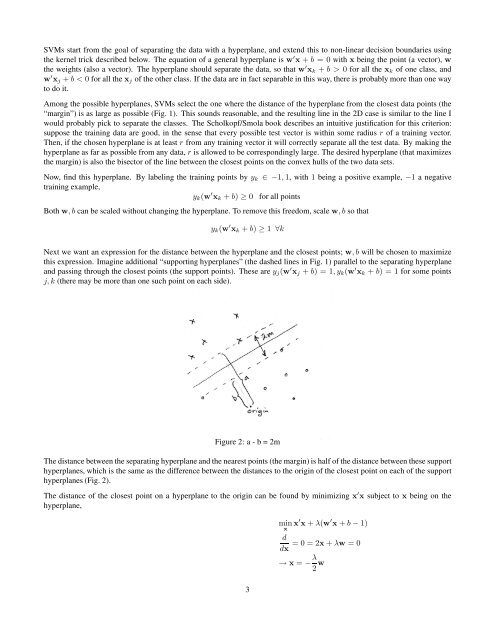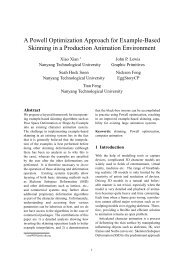A Short SVM (Support Vector Machine) Tutorial ... - JP Lewis
A Short SVM (Support Vector Machine) Tutorial ... - JP Lewis
A Short SVM (Support Vector Machine) Tutorial ... - JP Lewis
You also want an ePaper? Increase the reach of your titles
YUMPU automatically turns print PDFs into web optimized ePapers that Google loves.
<strong>SVM</strong>s start from the goal of separating the data with a hyperplane, and extend this to non-linear decision boundaries using<br />
the kernel trick described below. The equation of a general hyperplane is w ′ x + b = 0 with x being the point (a vector), w<br />
the weights (also a vector). The hyperplane should separate the data, so that w ′ x k + b > 0 for all the x k of one class, and<br />
w ′ x j + b < 0 for all the x j of the other class. If the data are in fact separable in this way, there is probably more than one way<br />
to do it.<br />
Among the possible hyperplanes, <strong>SVM</strong>s select the one where the distance of the hyperplane from the closest data points (the<br />
“margin”) is as large as possible (Fig. 1). This sounds reasonable, and the resulting line in the 2D case is similar to the line I<br />
would probably pick to separate the classes. The Scholkopf/Smola book describes an intuitive justification for this criterion:<br />
suppose the training data are good, in the sense that every possible test vector is within some radius r of a training vector.<br />
Then, if the chosen hyperplane is at least r from any training vector it will correctly separate all the test data. By making the<br />
hyperplane as far as possible from any data, r is allowed to be correspondingly large. The desired hyperplane (that maximizes<br />
the margin) is also the bisector of the line between the closest points on the convex hulls of the two data sets.<br />
Now, find this hyperplane. By labeling the training points by y k ∈ −1, 1, with 1 being a positive example, −1 a negative<br />
training example,<br />
y k (w ′ x k + b) ≥ 0 for all points<br />
Both w, b can be scaled without changing the hyperplane. To remove this freedom, scale w, b so that<br />
y k (w ′ x k + b) ≥ 1 ∀k<br />
Next we want an expression for the distance between the hyperplane and the closest points; w, b will be chosen to maximize<br />
this expression. Imagine additional “supporting hyperplanes” (the dashed lines in Fig. 1) parallel to the separating hyperplane<br />
and passing through the closest points (the support points). These are y j (w ′ x j + b) = 1, y k (w ′ x k + b) = 1 for some points<br />
j, k (there may be more than one such point on each side).<br />
Figure 2: a - b = 2m<br />
The distance between the separating hyperplane and the nearest points (the margin) is half of the distance between these support<br />
hyperplanes, which is the same as the difference between the distances to the origin of the closest point on each of the support<br />
hyperplanes (Fig. 2).<br />
The distance of the closest point on a hyperplane to the origin can be found by minimizing x ′ x subject to x being on the<br />
hyperplane,<br />
minx ′ x + λ(w ′ x + b − 1)<br />
x<br />
d<br />
= 0 = 2x + λw = 0<br />
dx<br />
→ x = − λ 2 w<br />
3







